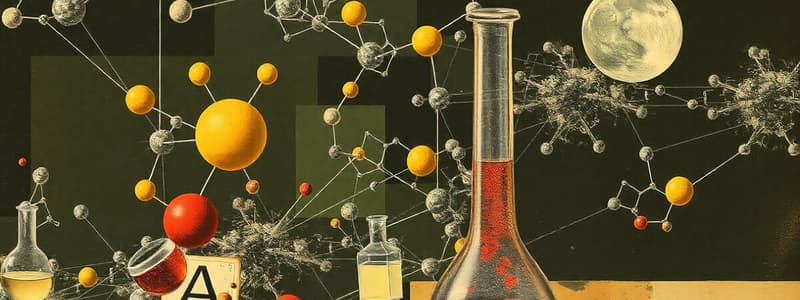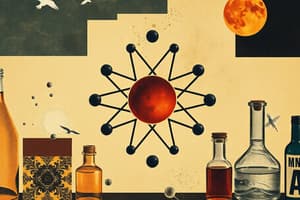Podcast
Questions and Answers
What type of elements usually form ionic compounds?
What type of elements usually form ionic compounds?
- Metalloids and metals
- Metals and metals (correct)
- Metals and nonmetals
- Nonmetals and nonmetals
What is the chemical symbol for the ion with 22 protons, 26 neutrons, and 19 electrons?
What is the chemical symbol for the ion with 22 protons, 26 neutrons, and 19 electrons?
- Na^+3
- Ti^+3 (correct)
- Ti^+2
- Ca^+3
How many electrons does the 79Se2– ion have?
How many electrons does the 79Se2– ion have?
- 35
- 37
- 33
- 36 (correct)
What is the total number of neutrons in the ion 79Se2–?
What is the total number of neutrons in the ion 79Se2–?
What is the mass number of the ion with 22 protons and 26 neutrons?
What is the mass number of the ion with 22 protons and 26 neutrons?
Which of the following compounds is classified as a molecular compound?
Which of the following compounds is classified as a molecular compound?
Which of the following pairs consist entirely of ionic compounds?
Which of the following pairs consist entirely of ionic compounds?
What type of bonding is present in P4O6?
What type of bonding is present in P4O6?
Which compound listed below is NOT a molecular compound?
Which compound listed below is NOT a molecular compound?
Identify the compound that consists of a mixture of molecular and ionic characteristics.
Identify the compound that consists of a mixture of molecular and ionic characteristics.
What defines an isotope of an element?
What defines an isotope of an element?
Which of the following isotopes of carbon has the most neutrons?
Which of the following isotopes of carbon has the most neutrons?
In a phosphorus-31 atom, how many protons does it have?
In a phosphorus-31 atom, how many protons does it have?
How many neutrons are present in a barium-138 atom?
How many neutrons are present in a barium-138 atom?
If the atomic number of an element is 6, what is the number of electrons in a neutral atom of this element?
If the atomic number of an element is 6, what is the number of electrons in a neutral atom of this element?
What are the rows called in the periodic table?
What are the rows called in the periodic table?
Which of the following correctly describes the columns in the periodic table?
Which of the following correctly describes the columns in the periodic table?
What is the primary characteristic observed in the chemical properties of elements in the periodic table?
What is the primary characteristic observed in the chemical properties of elements in the periodic table?
If an element belongs to the same group in the periodic table, what can be inferred about its chemical behavior?
If an element belongs to the same group in the periodic table, what can be inferred about its chemical behavior?
Which statement is true about the periodic table?
Which statement is true about the periodic table?
Which of the following elements is NOT considered a metalloid?
Which of the following elements is NOT considered a metalloid?
Where are metals primarily located on the periodic table?
Where are metals primarily located on the periodic table?
Which two elements are exceptions to the rule about metalloids being found along the stair-step line?
Which two elements are exceptions to the rule about metalloids being found along the stair-step line?
What term is used to describe elements that have properties of both metals and non-metals?
What term is used to describe elements that have properties of both metals and non-metals?
Which of the following is a property typically associated with metals?
Which of the following is a property typically associated with metals?
Which two elements are likely to have the most similar chemical and physical properties?
Which two elements are likely to have the most similar chemical and physical properties?
Which elements from the list are both nonmetals?
Which elements from the list are both nonmetals?
Which of the following statements about the elements B, Ca, F, He, Mg, and P is true?
Which of the following statements about the elements B, Ca, F, He, Mg, and P is true?
What type of element is helium (He)?
What type of element is helium (He)?
Among the following elements, which is most likely to be found in a gaseous state at room temperature?
Among the following elements, which is most likely to be found in a gaseous state at room temperature?
Flashcards
Ionic Bonds
Ionic Bonds
Ionic bonds form between metals and nonmetals, resulting in the transfer of electrons.
Ionic Compound Example
Ionic Compound Example
NaCl (sodium chloride) is an example of an ionic compound.
Ion with 22 protons, 26 neutrons
Ion with 22 protons, 26 neutrons
The ion with 22 protons, 26 neutrons, and 19 electrons is a 23/22Ca^2+ cation which would have a positive charge of 2.
79Se2– Ion Protons
79Se2– Ion Protons
Signup and view all the flashcards
79Se2– Ion Neutrons
79Se2– Ion Neutrons
Signup and view all the flashcards
79Se2– Ion Electrons
79Se2– Ion Electrons
Signup and view all the flashcards
Molecular Compounds
Molecular Compounds
Signup and view all the flashcards
Ionic Compounds
Ionic Compounds
Signup and view all the flashcards
Which compounds are molecular from the list: CBr4, FeS, P4O6, PbF2?
Which compounds are molecular from the list: CBr4, FeS, P4O6, PbF2?
Signup and view all the flashcards
Metalloids Location
Metalloids Location
Signup and view all the flashcards
Metals Location
Metals Location
Signup and view all the flashcards
Periodic Table
Periodic Table
Signup and view all the flashcards
Periods
Periods
Signup and view all the flashcards
Groups
Groups
Signup and view all the flashcards
Repeating Patterns
Repeating Patterns
Signup and view all the flashcards
Chemical Properties
Chemical Properties
Signup and view all the flashcards
Isotopes
Isotopes
Signup and view all the flashcards
Number of neutrons
Number of neutrons
Signup and view all the flashcards
Atoms of the same element
Atoms of the same element
Signup and view all the flashcards
Protons in 138Ba
Protons in 138Ba
Signup and view all the flashcards
Neutrons in 138Ba
Neutrons in 138Ba
Signup and view all the flashcards
Phosphorus-31
Phosphorus-31
Signup and view all the flashcards
Protons in Phosphorus-31
Protons in Phosphorus-31
Signup and view all the flashcards
Neutrons in Phosphorus-31
Neutrons in Phosphorus-31
Signup and view all the flashcards
Similar Chemical and Physical Properties
Similar Chemical and Physical Properties
Signup and view all the flashcards
Periodic Table Elements
Periodic Table Elements
Signup and view all the flashcards
Which elements show most similar properties?
Which elements show most similar properties?
Signup and view all the flashcards
Study Notes
Course Information
- Course Title: Organic Chemistry (AHS 111)
- Student Level: Pharm D, 1st level, 1st semester
- Faculty: Applied Health Sciences Technology
- Instructor: H. Hassan
Atoms, Molecules, and Ions
- Textbook: Chemistry, The Central Science, 10th edition by Theodore L. Brown, H. Eugene LeMay, Jr., and Bruce E. Bursten
- Topic covered: Atoms, molecules, and ions
Dalton's Postulates
- Atomic Theory
- Elements are composed of extremely small particles called atoms.
- Atoms of a given element are identical
- Atoms of one element cannot be converted into another element.
- Compounds are formed when atoms of multiple elements combine.
Atomic Structure
- Rutherford's Model
- Atom contains a very small, dense nucleus with electrons surrounding it.
- Most of the atom's volume is empty space
- Nucleus contains protons and neutrons
- Electrons occupy the volume around the nucleus
Subatomic Particles
- Proton Discovery (1919 by Rutherford)
- Neutron Discovery (1932, James Chadwick)
- Proton and Electron have charge
- Proton and Neutron have similar mass; electron mass is negligible
Table 2.1 Comparison of the Proton, Neutron, and Electron
-
Properties Proton Neutron Electron Charge Positive (1+) None (neutral) Negative (1-) Mass (amu) 1.0073 1.0087 5.486 × 10⁻⁴
Symbols of Elements
- Elements use one or two letters as symbols
- Atomic number (Z) = number of protons (or electrons)
- Mass number = number of protons + neutrons (used in isotopic symbols)
- Example: 12C - symbol for carbon, atomic number 6, mass number 12
Isotopes
- Atoms of the same element with different masses
- Different number of neutrons
- Example: Carbon isotopes: ¹¹C, ¹²C, ¹³C, ¹⁴C. Note ¹²C is most common (99%)
Periodic Table
- Organized arrangement of chemical elements.
- Elements arranged in order of increasing atomic number.
- Elements in the same group (column) have similar chemical and physical properties.
- Metals, nonmetals, and metalloids are organized by properties and location in the table
Periodicity
- Repeating patterns in chemical properties of elements across the periodic table.
- Groups (columns) have elements with similar properties.
Diatomic Molecules
- Seven elements (H₂, N₂, O₂, F₂, Cl₂, Br₂, I₂) occur naturally as molecules containing two atoms.
Chemical Formulas
- Subscripts in formulas indicate the number of atoms of each element in a molecule.
- Molecular compounds contain only nonmetals
Types of Formulas
- Empirical formula: lowest whole-number ratio of atoms in a compound.
- Molecular formula: exact number of atoms of each element in a molecule.
- Structural formulas: show order of bonding atoms.
Ions
- Atoms that lose or gain electrons to achieve noble gas configuration.
- Cations (positive ions) are formed by losing electrons.
- Anions (negative ions) are formed by gaining electrons.
Ionic Bonds
- Ionic compounds, like NaCl, form between metal and nonmetal atoms.
- Transfer of electrons from metal atoms to nonmetals.
Practice Questions
- Various practice questions/exercises given on determining the number of subatomic particles and writing chemical symbols for atoms and ions.
- Classify elements as metal, metalloid, or nonmetal.
Studying That Suits You
Use AI to generate personalized quizzes and flashcards to suit your learning preferences.




